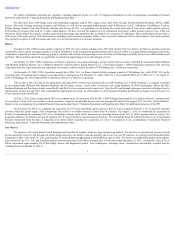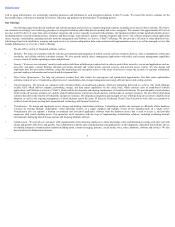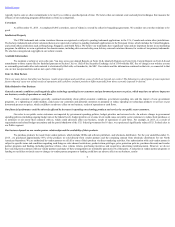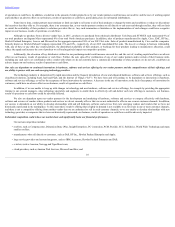CDW 2015 Annual Report Download - page 16
Download and view the complete annual report
Please find page 16 of the 2015 CDW annual report below. You can navigate through the pages in the report by either clicking on the pages listed below, or by using the keyword search tool below to find specific information within the annual report.
Table of Contents
Failure to comply with the laws and regulations applicable to our operations could adversely impact our business, results of operations or cash flows.
Our operations are subject to numerous U.S. and foreign laws and regulations in a number of areas including areas of labor and employment, advertising, e-
commerce, tax, import and export requirements, anti-corruption, data privacy requirements, anti-competition, and environmental, health, and safety. Compliance with these
laws, regulations and similar requirements may be onerous and expensive, and they may be inconsistent from jurisdiction to jurisdiction, further increasing the cost of
compliance and doing business, and the risk of noncompliance. We have implemented policies and procedures designed to help ensure compliance with applicable laws and
regulations, but there can be no guarantee against coworkers, contractors, or agents violating such laws and regulations or our policies and procedures. As a public company,
we also are subject to increasingly complex public disclosure, corporate governance and accounting requirements that increase compliance costs and require significant
management focus.
We have significant deferred cancellation of debt income.
As a result of a 2009 debt modification, we realized $395.5 million of cancellation of debt income (“CODI”). We made an election under Code Section 108(i) to
defer this CODI from taxable income, pursuant to which we are also required to defer certain original issue discount (“OID”) deductions as they accrue. As of December 31,
2013, we had deferred approximately $114.5 million of OID deductions. Starting in 2014, we were required to include the deferred CODI and the deferred OID into taxable
income ratably over a five-year period ending in 2018. Because we have more CODI than the aggregate of our deferred OID on the relevant remaining debt instruments, we
will have a future cash tax liability associated with our significant deferred CODI. We have reflected the associated cash tax liability in our deferred taxes for financial
accounting purposes.
All of our deferred CODI will be accelerated into current taxable income if, prior to 2018, we engage in a so-called “impairment transaction” and the gross value of
our assets immediately afterward is less than 110% of the sum of our total liabilities and the tax on the net amount of our deferred CODI and OID (the “110% test”) as
determined under the applicable Treasury Regulations. An “impairment transaction” is any transaction that impairs our ability to pay the tax on our deferred CODI, and
includes dividends or distributions with respect to our equity and charitable contributions, in each case in a manner that is not consistent with our historical practice within
the meaning of the applicable Treasury Regulations.
Prior to 2018, our willingness to pay dividends or make distributions with respect to our equity could be adversely affected if, at the time, we do not meet the 110%
test and, as a result, the payment of a dividend or the making of a distribution would accelerate the tax payable with respect to our deferred CODI. We believe that, based on
our interpretation of applicable Treasury Regulations, the gross value of our assets exceeds 110% of the sum of our total liabilities and the tax on the net amount of our
deferred CODI and OID as of the filing date of this Annual Report on Form 10-K. However, we cannot assure you that this will continue to be true in the future.
Risks Related to Our Indebtedness
We have a substantial amount of indebtedness, which could have important consequences to our business.
We have a substantial amount of indebtedness. As of December 31, 2015 , we had $3.3 billion of total long-term debt outstanding, as defined by GAAP, and $439.6
million of obligations outstanding under our inventory financing agreements, and the ability to borrow an additional $843.1 million under our senior secured asset-based
revolving credit facility (the “Revolving Loan”) and an additional £ 50.0 million ( $73.7 million ) under our Kelway revolving credit facility (“Kelway Credit Facility”). Our
substantial indebtedness could have important consequences, including the following:
• making it more difficult for us to satisfy our obligations with respect to our indebtedness;
• requiring us to dedicate a substantial portion of our cash flow from operations to debt service payments on our and our subsidiaries’ debt, which reduces the funds
available for working capital, capital expenditures, acquisitions and other general corporate purposes;
• requiring us to comply with restrictive covenants in our senior credit facilities and indentures, which limit the manner in which we conduct our business;
• making it more difficult for us to obtain vendor financing from our vendor partners, including original equipment manufacturers and software publishers;
• limiting our flexibility in planning for, or reacting to, changes in the industry in which we operate;
• placing us at a competitive disadvantage compared to any of our less-leveraged competitors;
15
























